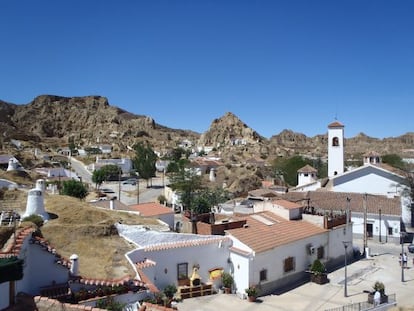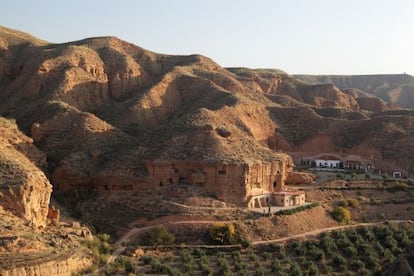Back to the stone age
The town of Guadix in Granada is proud to be Europe’s cave-dwelling capital

With the economy in a tailspin, some Spaniards may be considering going back to cave life to get away from it all.
They would not be the first.
Granada province alone has over 12,000 caves, according to the Andalusian Association of Rural Tourism in Cave Dwellings (AATRCC). Of these, around 3,500 are currently used as a first residence, with another 400 serving as holiday homes and 300 functioning as small hotels.
Caves have been used for a variety of purposes since prehistoric times, but few places have developed entire neighborhoods of complex mountain dwellings that continue to be home to thousands of people. Guadix, on the northern foothills of Sierra Nevada, is proud of its “European Cave Capital” status. One of the oldest human settlements in the peninsula, there is an air of faded glory about the numerous landmarks that crowd this town of just 20,000 residents, including a Roman Catholic cathedral, a Moorish fortress, a Jewish quarter and a Roman theater.
But many people come to see the “barrio de las cuevas” (or, cave quarter), which can be reached on a tourist train departing from the cathedral square. At first it looks like a typical Andalusian white village, but closer inspection reveals that there is nothing there but whitewashed façades and chimneys sticking out of the ground. Some 4,500 people live in these 2,000 underground houses, two of which are open to the public; the owner of one, José, proudly shows visitors into his home, as though to prove that today’s caves have all the mod cons one could wish for, including dishwashers and wi-fi internet access – even hot-tubs in some cases.
What cave homes lack is air conditioning, because the natural indoor temperature is around 20ºC all year round regardless of the outside weather, which can surpass 40ºC in summer and drop to zero in winter. This desirable feature is partly what is driving a wave of popularity for cave tourism in the area. Last year, the industry brought in 12 million euros and around 50,000 people stayed at cave hotels in Andalusia, according to AATRCC figures.

“We have 80 percent of existing caves in Europe and we offer tourists a unique form of accommodation in establishments that meet all the requirements of any rural lodging,” association manager Eufemio López told Efe news agency. “When the heat really hits, caves become a perfect oasis that lets you sleep with blankets.”
Some entrepreneurs have taken the concept even further and created a whole environment that recreates what life was like for past inhabitants of these singular homes. Manuel José García and Dulce María Jiménez, the owners of Cuevas Almagruz, near the town of Purullena, have embarked on a personal mission to restore the cultural heritage of this corner of Spain. Besides renting out six “cave apartments” decorated in a rustic chic style with impressive views of the mountains, the complex stands out for its unique “interpretation center,” a museum-exhibition center-workshop that includes a tour of a cave restored to the conditions in which it was inhabited until 1970, complete with straw mattresses, oil lamps and wood-fired oven.
Three more caves exhibit farming tools and handicrafts, and the center also organizes educational projects in partnership with schools to teach children about traditional crafts such as soapmaking and fruit preserves. Dulce, who is in charge of the center’s educational projects, demonstrates an encyclopedic knowledge of local customs, flora, fauna and geology during her comprehensive tour of the interpretation center. Meanwhile, Manuel José – Manolo – takes visitors to nearby places of interest such as the “badlands of Purullena,” a breathtaking landscape created through the erosion of clay-rich soils that gave rise to row upon row of capriciously shaped ravines. As Manolo admits, tourism in this part of Spain is notably underdeveloped, but then again, “if there were busloads of people coming up here, the place would lose part of its charm.”
Tu suscripción se está usando en otro dispositivo
¿Quieres añadir otro usuario a tu suscripción?
Si continúas leyendo en este dispositivo, no se podrá leer en el otro.
FlechaTu suscripción se está usando en otro dispositivo y solo puedes acceder a EL PAÍS desde un dispositivo a la vez.
Si quieres compartir tu cuenta, cambia tu suscripción a la modalidad Premium, así podrás añadir otro usuario. Cada uno accederá con su propia cuenta de email, lo que os permitirá personalizar vuestra experiencia en EL PAÍS.
¿Tienes una suscripción de empresa? Accede aquí para contratar más cuentas.
En el caso de no saber quién está usando tu cuenta, te recomendamos cambiar tu contraseña aquí.
Si decides continuar compartiendo tu cuenta, este mensaje se mostrará en tu dispositivo y en el de la otra persona que está usando tu cuenta de forma indefinida, afectando a tu experiencia de lectura. Puedes consultar aquí los términos y condiciones de la suscripción digital.








































